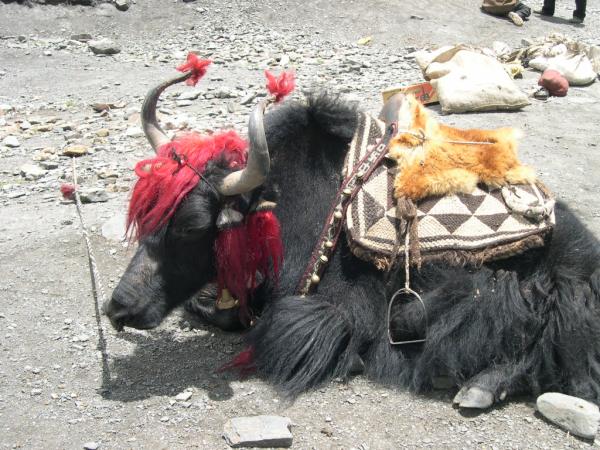Home >
여행 상품평/후기
| 제목 | 티벳에서 들려주는 티벳 이야기입니다. |
|---|---|
| 작성일 | 2010.06.21 |
| 작성자 | 조*제 |
| 상품/지역 | 트레킹 |
|
안녕하세요, 혜초여행사 조민제 대리입니다. 앞으로 티벳 현지에서 저와 절친한 티벳인 Tashi norbu라는 친구가 티벳에 관심을 가지는 한국분들을 위해 티벳 현지 소식을 알려드릴 예정입니다. 그럼 첫 소식으로 티벳의 야크에 대해 알려드리도록 하겠습니다. (현지 원어도 같이 첨부하도록 하겠습니다. 혹시 불신을 가지실까봐...^^;) Tibetan Yak. For centuries, Yaks has been the living on the high pleatues all around the world and most prominently in Tibetan pleateaus. Fifty years ago,an estimated one million wild yaks roamed the tibetan pleateau. Now a days we could hardly catch a glimpse of this impressive black bovine, which weighs up to a tonne,whose shoulder height reaches over 1.8meters and whose sharp, slender horns span 1meters. Wild yaks have deminished in numbers to 15000 as a results of the increased demand for yak meats and a rise in hunting. Although eating yak meats is not sacrilegious in tibetan culture,hunting wild yaks is illegal. A domestic yak rarely exceeds 1.5m in height. Unlike its wild relatives,it varies in shade from black to grey and white. Despite their massive size,yaks are surprisingly sure footed and graceful on steep,narrow trails, while burdened by loads of upto 70 kgs. Yaks are also used for the irrigation of fields around Tibet. Yaks panic easily and will struggle to stay close togather. The Tibetan nomads have valued the yaks. Tibetan rely on yak milk for cheese,as well as for butter for butter tea which is the best component with Tsampa(Tibetan staple food) and offerings for the butter lamps in monasteries. The outer hair of the yak is woven into tent fabric and rope, as seens in the Grassland areas where Nomads stays in their Yak hair tends with their animals,as the black colour maintains the heat,and the soft inner wool is spun into Chara which is used to make bags, blankets and tents,even yaks dung is being used a fundamental fuel,let to dry in little cakes on the walls of most Tibetan houses specially at villages houses. With regards, Tashi Norbu. 티벳의 야크 수세기동안 야크는 전 세계 고지대 지역에서 살고 있으며, 특히 티벳고원에 서식하고 있습니다. 50년 전만 해도 대략 100만 마리의 야생야크가 티벳 고원에서 서식했습니다. 그러나 요즘은 무게가 1톤이 넘고, 어깨가 1.8m 이상이고, 날카롭고 예리한 1m 이상의 뿔을 가진 인상적인 블랙야크를 보는 것이 쉽지는 않습니다. 야크고기의 수요와 샤냥으로 15,000여 마리의 야크가 사라지고 있습니다. 야크를 먹는것은 티벳의 신성을 더럽히는 문화는 아니지만 야크를 사냥하는 것은 불법입니다. 티벳에서 1.5m를 넘는 야크는 거의 없습니다. 야생의 야크하고는 달리 검정, 회색, 백색을 띠고 있습니다. 육중한 몸에도 불구하고 70kg 이상의 짐을 이고 좁고 가파른 길을 가볍게 이동합니다. 또한 야크는 티벳 주변의 토양을 비옥하게 하는데 좋은 영향을 끼칩니다. 티벳 유목민들은 야크를 매우 소중하게 여깁니다. 티벳인들은 야크의 원유를 통해 치즈를 얻으며, 버터는 티벳인들의 주식인 참파와 수유차로 먹습니다. 또한 버터는 사찰의 등불을 밝히는데 사용합니다. 티벳인들은 야크 바깥 표면의 털을 이용해 텐트의 직물이나 줄을 만들고 보온도 유지합니다. 야크 안쪽 털을 짜서 'Chara'라는 것을 만드는데 이것은 가방, 담요, 텐트를 만들 때 사용합니다. 또한 야크의 똥은 티벳인들의 주된 연료입니다. 작은 덩어리로 건조된 야크의 똥을 티벳인들은 집의 벽 재료로도 사용합니다. |
|
| 이전글 | 황산의 아름다움을 어디에 비하겠습니까! |
|---|---|
| 다음글 | 백두산 (남파-서파-북파) |



 전체 메뉴
전체 메뉴
 목록
목록

 예약가능
예약가능 예약마감
예약마감 대기예약
대기예약 출발확정
출발확정